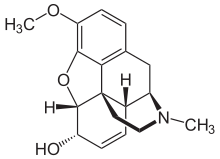Codeine phosphate
 |
|
 |
|
| Clinical data | |
|---|---|
| AHFS/Drugs.com | Monograph |
| MedlinePlus | a682065 |
| Pregnancy category |
|
| Dependence liability |
High |
| Routes of administration |
by mouth, rectal, SC, IM |
| ATC code | |
| Legal status | |
| Legal status |
|
| Pharmacokinetic data | |
| Bioavailability | By mouth: ~90% |
| Metabolism | Liver: CYP2D6 (to morphine), CYP3A4 (to norcodeine), UGT2B7 (to 3- and 6-glucuronides of codeine, norcodeine, and morphine) |
| Onset of action | 15–30 minutes |
| Biological half-life | 2.5–3 hours |
| Duration of action | 4–6 hours |
| Identifiers | |
|
|
| Synonyms | 3-Methylmorphine |
| CAS Number | |
| PubChem CID | |
| IUPHAR/BPS | |
| DrugBank | |
| ChemSpider | |
| UNII | |
| KEGG | |
| ChEBI | |
| ChEMBL | |
| ECHA InfoCard | 100.000.882 |
| Chemical and physical data | |
| Formula | C18H21NO3 |
| Molar mass | 299.364 g/mol |
| 3D model (Jmol) | |
|
|
|
|
|
|
|
Codeine is an opiate used to treat pain, as a cough medicine, and for diarrhea. It is typically used to treat mild to moderate degrees of pain. Greater benefit may occur when combined with paracetamol (acetaminophen) or a nonsteroidal anti-inflammatory drug (NSAID) such as aspirin or ibuprofen. Evidence does not support its use for acute cough suppression in children or adults. In Europe it is not recommended as a cough medicine in those under twelve years of age. It is generally taken by mouth. It typically starts working after half an hour with maximum effect at two hours. The total duration of its effects last for about four to six hours.
Common side effects include vomiting, constipation, itchiness, and lightheadedness. Serious side effects may include breathing difficulties and addiction. It is unclear if its use in pregnancy is safe. Care should be used during breastfeeding as it may result in opiate toxicity in the baby. Its use as of 2016 is not recommended in children. Codeine works following being broken down by the liver into morphine. How quickly this occurs depends on a person's genetics.
Codeine was discovered in 1832 by Pierre Jean Robiquet. In 2013 about 361,000 kilograms of codeine were produced while 249,000 kilograms were used. This makes it the most commonly taken opiate. It is on the World Health Organization's List of Essential Medicines, the most effective and safe medicines needed in a health system. The wholesale cost in the developing world is between 0.04 and 0.29 USD per dose as of 2014. In the United States it costs about one dollar a dose. Codeine occurs naturally and makes up about 2% of opium.
...
Wikipedia
